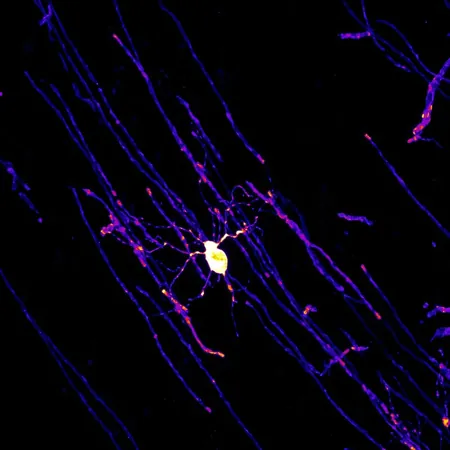
Groundbreaking Study Unveils Unique Aquaporin-4 Patterns in Parkinson's and Multiple System Atrophy
2025-09-16
Author: Sarah
Revealing Insights from Postmortem Analysis
A revolutionary study featured in Movement Disorders has shed light on the intriguing role of aquaporin-4 (AQP4), a crucial protein for clearing harmful amyloid proteins, in the brains of patients battling Parkinson's disease (PD) and multiple system atrophy (MSA). Researchers have identified distinct patterns of AQP4 distribution in these conditions, particularly within the brain's superficial cortical layers, pointing towards unique astrocytic reactions in different types of neuronal disorders.
A Deep Dive into the Research Methodology
In this extensive investigation, the brains of 29 individuals with PD, 19 with MSA, and 17 control subjects were analyzed. The focus was on the motor cortex and subcortical white matter, revealing that AQP4 polarization was markedly higher in PD patients compared to controls and those with MSA. Notably, the study discovered that AQP4 levels appeared to correspond with age-related plaque formation, particularly showing elevated levels in female controls.
What the Experts Are Saying
"Our findings highlight critical changes in AQP4 presence in the motor cortex, exceedingly related to plaque development, Lewy bodies, and MSA pathology," stated Dr. YuHong Fu, the study's senior author and Neuroscience Fellow at The University of Sydney. This pivotal study indicates a potential connection between increased AQP4 levels and enhanced clearance capabilities in the brains of older adults.
Diving into the Data: The Takeaways
Upon analyzing AQP4 polarization and abundance, researchers found interesting correlations. While polarization showed a positive correlation with area and intensity, the abundance of AQP4 negatively correlated with polarization area. In controls, mild neuritic plaques were linked to higher AQP4 levels, underscoring an adaptive astrocytic response to aging.
Unpacking the Distinctions in Disease Types
In PD patients, AQP4 polarization surged in superficial brain regions, independent of plaque presence. Early PD cases even demonstrated lower polarization, suggesting varying astrocytic responses as the disease progresses. Conversely, MSA cases showed robust AQP4 labeling in reactive astrocytes, although α-synuclein aggregates were minimal. Notably, the MSA-parkinsonian type (MSA-P) displayed a decrease in AQP4 polarization, while the cerebellar type (MSA-C) remained unchanged.
Astounding Findings on Astrocytic Density
Overall, astrocytic density and the percentage of AQP4-positive astrocytes showed minimal change across all groups, with early PD cases revealing a decline in AQP4 recruitment. The MSA-C cases, however, maintained strong AQP4 end-feet recruitment, setting them apart from MSA-P and control cases.
Next Steps in Understanding AQP4 Dynamics
Dr. Fu and colleagues concluded that early PD and MSA-P exhibit impaired AQP4 polarization, which may disrupt glymphatic functioning and align with notable neuroimaging shifts. While MSA-C showed no polarization change, late-stage PD revealed increased polarization, indicating a dynamic alteration in AQP4's role within these conditions. Many questions remain, paving the way for future explorations into the intricate relationship between AQP4 and neurodegenerative disease progress.



 Brasil (PT)
Brasil (PT)
 Canada (EN)
Canada (EN)
 Chile (ES)
Chile (ES)
 Česko (CS)
Česko (CS)
 대한민국 (KO)
대한민국 (KO)
 España (ES)
España (ES)
 France (FR)
France (FR)
 Hong Kong (EN)
Hong Kong (EN)
 Italia (IT)
Italia (IT)
 日本 (JA)
日本 (JA)
 Magyarország (HU)
Magyarország (HU)
 Norge (NO)
Norge (NO)
 Polska (PL)
Polska (PL)
 Schweiz (DE)
Schweiz (DE)
 Singapore (EN)
Singapore (EN)
 Sverige (SV)
Sverige (SV)
 Suomi (FI)
Suomi (FI)
 Türkiye (TR)
Türkiye (TR)
 الإمارات العربية المتحدة (AR)
الإمارات العربية المتحدة (AR)